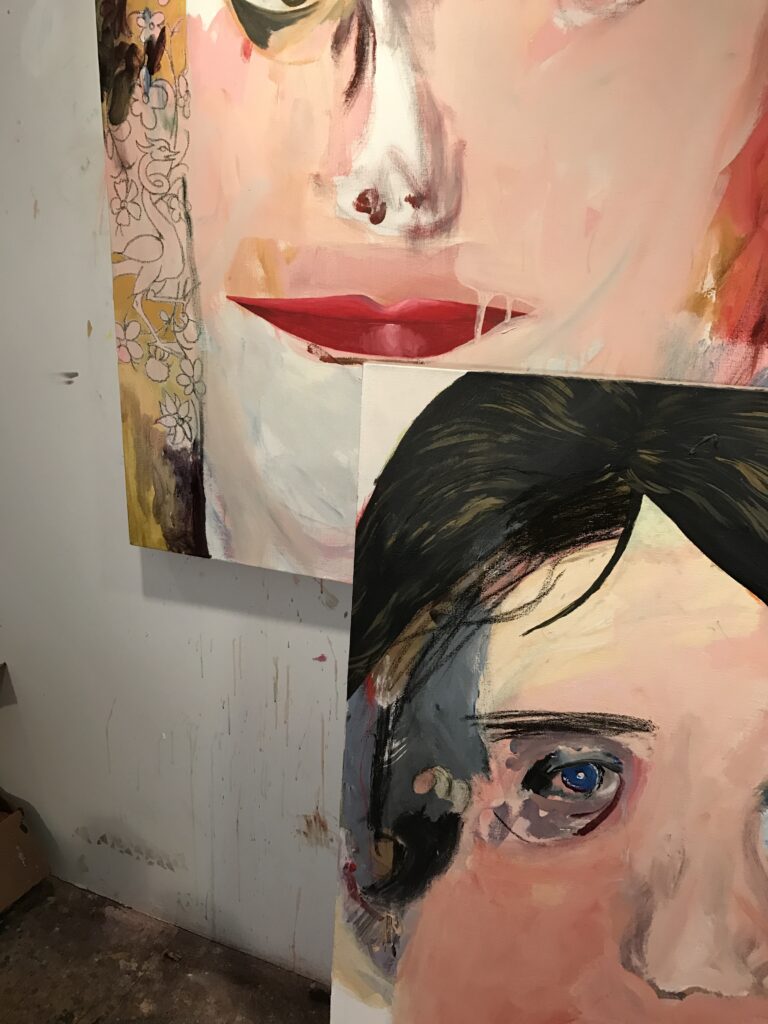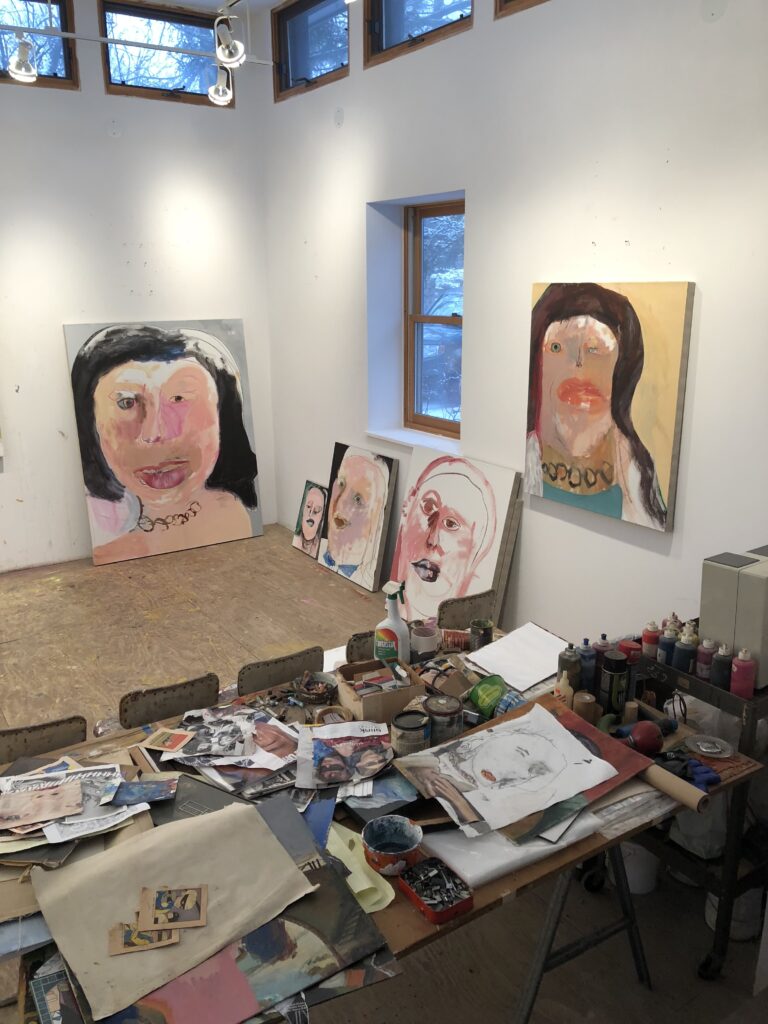
Margot Bergman’s studio. Photograph courtesy of Corbett vs. Dempsey, Chicago.
Do cups have souls? If you look at Margot Bergman’s portfolio in our Summer issue, you might be tempted to say yes: the cups she has painted, from various vantage points and in bright colors, seem filled with life. Bergman, who was born in 1934, has been painting for nearly her whole life. She is best known for her series Other Reveries, which features collaborative portraits painted over artworks she has saved from flea markets and thrift stores. Each painting is layered with decisive, bold paint strokes, revealing a face latent with layers of emotions. They are at once beautiful, frightening, humorous, and welcoming. Who knew that cups could contain similarly human emotion? We talked about the joys of painting, the female form, and of course, what drew her to cups in the first place.
—Na Kim
INTERVIEWER
Much of your work revolves around faces, and especially female figures. When did start painting these?
MARGOT BERGMAN
In the fifties. The artist R. B. Kitaj was painting very flat paintings. I was attracted to his style. I began to paint like that. I still have some of those paintings in the basement of my home, left over from the fifties—a series of flat paintings of naked women. They were very flat, very unsexual, though the women were butt naked, with their backs turned to the viewer. At one point, the city of Milwaukee, Wisconsin, wanted some of my paintings for the hallway of a government building. They were these Kitaj-like paintings of women, all naked, their backs turned, with what look like bits of collage randomly placed in the paintings. There was a controversy, and the paintings made it in to the newspaper in Milwaukee, because some women’s group had demanded for them to be taken down.
INTERVIEWER
What happened?
BERGMAN
They were taken down. It was the fifties. I thought it was so funny. And kind of outrageous, but mostly I thought it was funny. Strange, funny, and uninformed.
INTERVIEWER
These women with their backs turned, were they all the same woman, or different women? Who were they?
BERGMAN
I have no idea. But they did not represent me. They were very planiform. There was no voluptuousness to them. There was no shading. They really revealed form. They had shapes, but no real substance. And they were looking out into a courtyard, and the coloring was a bit Impressionist. They were really not expressionistic in any way. I would say that I was influenced by Pierre Bonnard at this time—that was probably my first true love of an artist’s work.

Margot Bergman’s studio. Photograph courtesy of Corbett vs. Dempsey, Chicago.
INTERVIEWER
What about Bonnard was particularly inspiring to you?
BERGMAN
I thought his work was beautiful. I thought it was intimate. Later in life, what I’ve come to know is that there was an intimacy to his work that I was not seeing in the work of other artists. And that’s probably what drew me to him.
INTERVIEWER
What led you to start painting the cups that are featured in our Summer issue?
BERGMAN
I had started another body of work that wasn’t working. I was disappointed in it. It had to do with bricks, both rigid urethane ones and children’s building blocks. They were three-dimensional, and I was trying to do paintings of the bricks so that the works on paper were geometric forms. I just could not make them work. So I tore one of them up. I tore up a piece of paper in my frustration, and then I just made a painting of a cup on one of the scraps. God knows. God knows why.
Perhaps now I can look at it and say that the original work had so much geometry, so many hard lines, that I needed a circle. But that really did not go through my mind. My process is very intuitive. I just found myself making a circular form, and the form that came out was a cup. Then the cups came in a rush—I’ve now done seventy of them. It was one after another, after another, after another, just pouring out of me.
INTERVIEWER
I wanted to talk about another important body of your work—your found collaborative paintings, which are portraits overpainted on paintings you often find in flea markets and thrift stores. There’s something so haunting about them. The faces really stare back at you. Do you ever think of real people when you’re painting them, or are they people who come from your mind?
BERGMAN
No, I do not think of them as real people. But when they come out, they frequently have names. There is something in my subconscious that finds a name. I don’t analyze it. Almost always, after a portrait is done, I know the figure’s name. It’s like the painting itself: it just is.

Margot Bergman’s studio. Photograph courtesy of Margot Bergman.
INTERVIEWER
What led you to begin painting over the works of others?
BERGMAN
Before I started making those paintings, I was embedded in the world of art. I was in the galleries. I had lived in New York. I walked the walk and did the talking, and I realized that I was uninspired by the things I was making and didn’t like what I was seeing on the walls either. These works had no heart for me. And when I would go to a flea market, it was all heart. There were these inexperienced artists who were giving everything to make something that they truly cared about. I was drawn to that, so I would bring their work back to the studio. At first, I felt it was a no-no to paint on them, so I didn’t, but I kept collecting them. And then, one day, I just saw a face in one of them, and I painted it on top. That was very satisfying. For about ten years, I worked on that body of work. I had to go out and hunt down these kinds of paintings, which is not an easy thing to do. And nobody wanted the paintings I did with them. I tried in Chicago to have them be seen. Until John Corbett came along, many years later, nobody would show them. I had pulled myself away from whatever I thought was the art world, and I was making strictly for myself. I love them. I love doing it.
INTERVIEWER
You talked a little bit about the difficulties of being an artist. What would you say were some major roadblocks for you?
BERGMAN
It’s trite to say it, because everybody knows it. But let’s start with being a woman. I had children. I was married. I lived in the suburbs of Chicago in the fifties and I had a husband who could support me. I was attractive. I had no network because I didn’t finish my degree at the Art Institute—I got married when I was twenty-one, and my husband was in service and I followed him. How many things worked against me there? I was not part of anything, and I was different, then. But it didn’t stop me from painting, ever, ever, ever, ever. I worked like hell. I was always working. I think we’re working even when we’re not working. I think when we walk in our space and we sweep the floor, we are working. It is something that’s inexplicable.
INTERVIEWER
What part of the painting process would you say is your favorite, if you have one?
BERGMAN
I like pencils. I like paint. I love paint. I love paint. I love mark-making. I love the end, when one can see something that one could say is complete.
INTERVIEWER
How do you know when a painting is done?
BERGMAN
Sometimes I’ve been right and sometimes I’ve been wrong. I’ve often thought, Can I make it better if I keep going? It’s a well-known fact that artists can leave their studio or workspace, think they have completed a painting and are satisfied with it, and come back the next day and say, “Oh my gosh, that’s not nearly what I thought it was.” So, how do we know? We don’t always.
INTERVIEWER
Is painting intuitive to you? Do you find it difficult?
BERGMAN
I don’t take myself too seriously until I need to be serious. I like playing. I don’t mean that I am not working seriously. I am looking hard, but I’m also having a very good time. Painting is a very joyful process for me. And even though it can have dark undertones, for me, painting is the unearthing of whatever is there for me to find. That’s just intuitive.
INTERVIEWER
Where do you think this curiosity and urge to create comes from?
BERGMAN
When someone comes to me and says, “I just traveled to India, and I did this, and I did that,” I think to myself, I just traveled on my own adventure. I love adventure, and I equate what’s happening to me on the canvas with a journey. My journey has no map.
Na Kim is the art director of the Review.
from The Paris Review https://ift.tt/SdgYzDc
Comments
Post a Comment